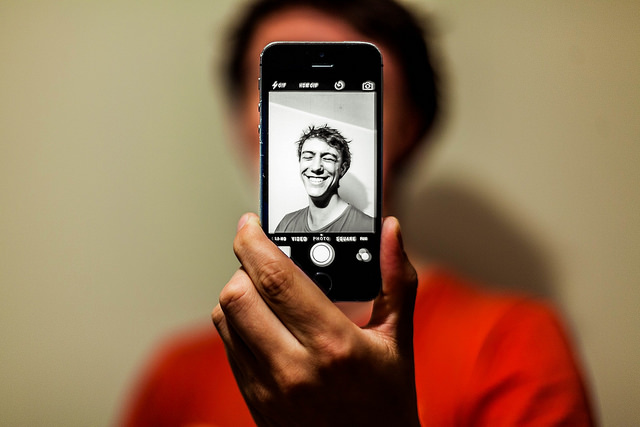
Selfie image via Flickr
Selfies will never be the same again.
Huge news struck the selfieverse this week when Apple announced that the long-awaited iPhone X (pronounced “X,” not “ten”) could be unlocked using only the owner’s selfie through a complex facial recognition system called Face ID.
With the rise of facial recognition technology, the fact that Apple chose to use Face ID is not surprising. But the fact that there is no other way to unlock a new iPhone X is bizarre; even the Touch ID phones offer passcode options.
Apple wants consumers to feel physically attached to their phones, though, and it has already been using biometrics as a way to unlock the phone. Face ID is the next level up from Touch ID, which uses your fingerprint to unlock the phone and has been available since the 2013 iPhone 5S.
As I write about in chapter two, “Privacy Settings” in my forthcoming book The Selfie Generation (Skyhorse), out November 7, 2017, the selfie in any iteration becomes both a harbinger of what the future of selfie culture could become, and what it already is:
“In this way, the selfie acts almost as a moment of defiance mixed with an awareness of just how surveilled our lives are today. The selfie is a declaration of an already data-exploited self online, and one that is also imaged even through simple situations such as security cameras in stores, at airports, or in other public spaces.”
Apple’s decision to require Face ID to unlock the phone symbolizes a forced “selfie.” Though not an image in and of itself, the Face ID is easily referred to as a selfie because it literally is a reflection of the face in a smartphone.
Questions that Face ID will bring up in crime, legal situations
Security experts suggest using a long, random passcode of at least six digits and never using Apple’s fingerprint technology to unlock your phone.
In my book, I discuss a 2014 ruling by Circuit Court judge Steven C. Frucci in Virginia that explains how “a criminal defendant can be compelled to give up his fingerprint, but not his pass code, to allow police to open his cellphone,” according to a report from the Virginian-Pilot. The rationale behind this was that a fingerprint is “akin to providing a DNA or handwriting sample or an actual key,” which is permitted by law. “A pass code, though, requires the defendant to divulge knowledge, which the law protects against, according to Frucci’s written opinion.”
What will this mean for Face ID? Will a criminal defendant be forced to give up their selfie to the police, allowing them to open a cellphone?
Apple’s Face ID will certainly bring up new types of questions about data, who has access to them, and how it is legally (and illegally) accessed.
Not the first time selfies have unlocked accounts
Financial institutions were already on it with selfie-related technologies several years ago, before you started freaking out about iPhone X’s Face ID just the other day.
At the 2015 Money 20/20 conference in Las Vegas, Acuity Market Intelligence projected that the global market for biometrics would hit more than $117 billion by 2020. MasterCard unveiled “Selfie Pay,” an app that let people verify their identity by taking a selfie rather than entering a passcode or using their fingerprint.
The following year, in 2016, MasterCard launched Selfie Pay. President, Enterprise Safety and Security at MasterCard, Ajay Bhalla, noted, “We want to identify people for who they are, not what they remember,” regarding the use of biometric authentication. The implications for “who they are” suggest that who you are only exists in the present selfie moment, oddly, rather than where you have been and how you got there. MasterCard rolled out Selfie Pay, which was launched, around the world.
The company also said that it was working on other ways to authenticate users’ purchases using biometrics as literally personal as “a customer’s heartbeat.” Creepy!
What does this mean for the future of selfie?
The forced use of the selfie through Face ID in order to unlock a phone brings up many new questions about who has access to what, and also how dead the idea of “privacy” truly is.
In order for Face ID to work, however, the person has to stare straight at it — not like off to the side. But what if you change your look or hair or, get plastic surgery? Will Face ID recognize you? Apple says so, but let’s wait and see what happens.
The other worst case scenario is thinking of people being forced to open their phones with their faces. I can think of countless plot points in films or television shows where someone needs to get into another person’s phone, yet the person is not conscious enough to do it themselves – but their hand is physically there, and their fingerprint is available.
In the film “The Big Sick,” there’s a scene where Kumail Nanjiani’s girlfriend is in a coma but he needs to get a phone number from her phone. He takes her hand and places her finger onto the iPhone button, and boom, there he has access to her phone, all her texts, and basically her entire life! His reasons were benign — to call her parents and let them know she was in the hospital — but what if they were not? What if this was a horror film instead of a romcom?
Further questions about privacy in relation to biometrics will come up with Face ID. But still the bigger question here is always: Who owns our data, and what are they doing with it? As biometrics and facial recognition technologies continue to expand, the selfie will take on even greater importance.
This post was edited by the fabulous Alex Huntsberger. Follow him on Twitter @AlexTheHuntsy.



